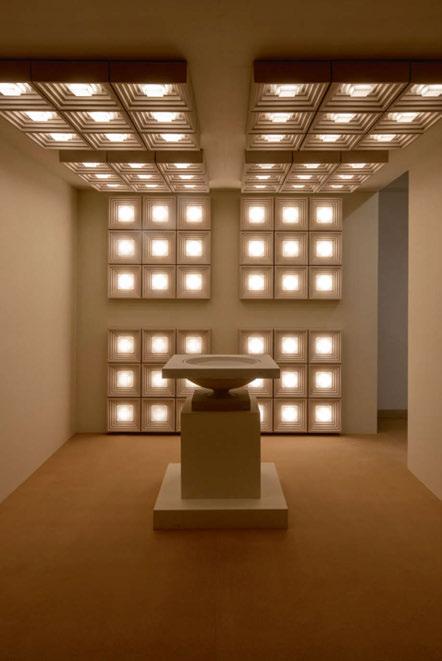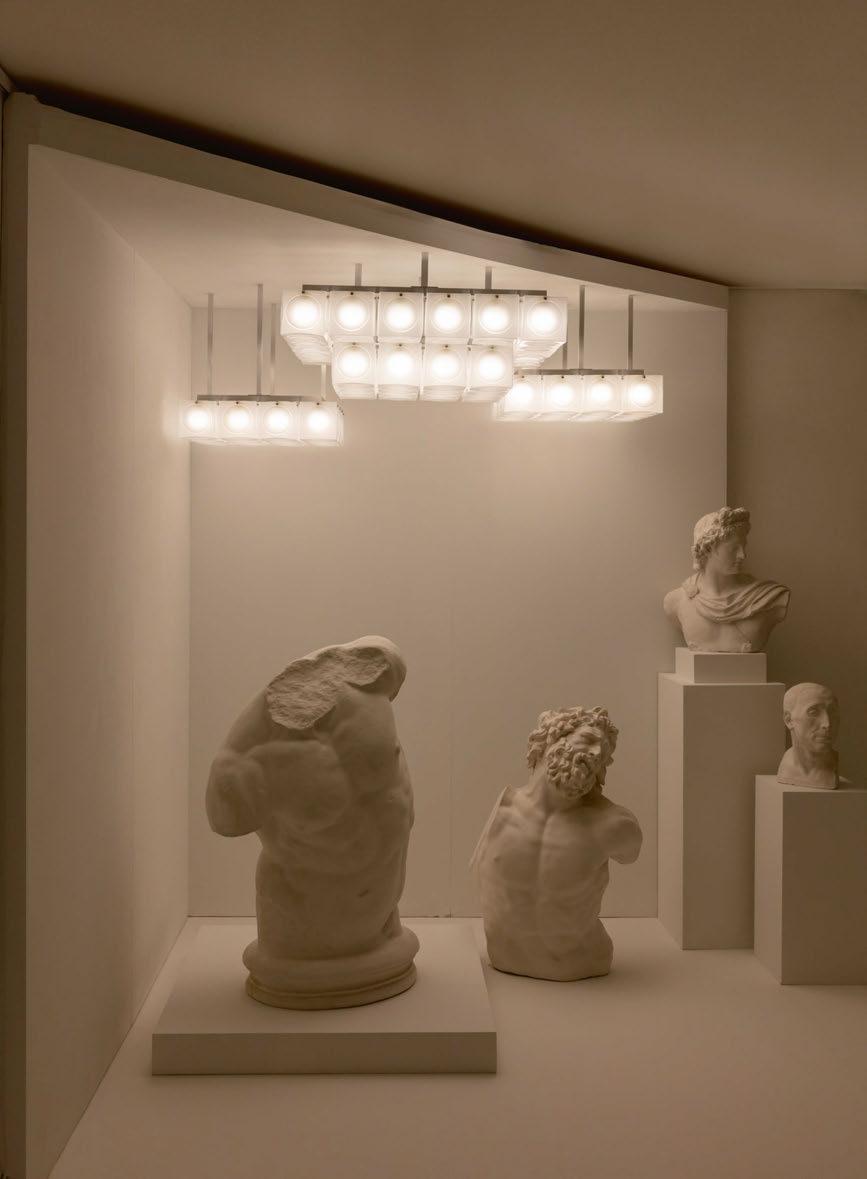
8 minute read
Lee Broom | Divine Inspiration


To mark the brand’s 15th anniversary, Lee Broom presented Divine Inspiration, his first lighting release in four years, which displayed six new lighting collections.
The exhibition showcased a series of ethereal and dramatic rooms, each featuring a piece from the collection, that led visitors through a theatrical experience inspired by religious houses of worship. The delicately curated journey explored the typical relationship between light and holy places, and evoked feelings of “stillness, reverence, and contemplation” for visitors as they passed through the multi-levelled gallery. Taking inspiration from architecture, Broom particularly focused on the Brutalist aesthetic. This led him to explore places of worship across various time periods, looking at the design language associated with religious architecture, interiors, and artefacts. The Divine Inspiration takes aesthetic nods from the “pared-back silhouettes of Modernism and Brutalism architecture that surrounded Broom as he grew up”. Interviewed by darc during Milan Design Week, Broom says of the exhibition: “I’m always looking at things from the past with my collections. I always like to look back before trying to look forward. Everything that you do has a reference point from somewhere. And I think part of the thing that makes my products modern yet classic at the same time, is that I do reference things,” he explains. “It gives you


Room 1: Pantheum
the notion that you’ve seen it before, but not quite in the same way. We’re not trying to reinvent the wheel; I’m just trying to make people look at things in a different way, and I think that’s very typical of this collection. With future collections, I’m sure that I will definitely tap into some sort of other art form, whether it be historical or not. I tend to be drawn particularly to periods such as Bauhaus and Art Deco, the Mid-Century movement and then late 1970s Italian furniture as well. Those are the kinds of things that are always in life, or have been over the past 10 years,” he says. “I also think it’s kind of nostalgic in a way; I was born in the 70s, and I think looking back at how your parents grew up, or what you have around you when you were growing up influences you. I was always massively into design and furniture and lighting when I was young. I used to do lots of trips to London with my mum, we would go to these incredible modernist furniture stores. I didn’t know the designers at that point, but I was always a huge fan of post-modernism and post-modernist architecture, for instance. So, you can kind of see that in my work. “I grew up in Birmingham, so there was a lot of brutalist architecture in that city. I personally loved it, but a lot of people didn’t and unfortunately some amazing pieces have been demolished, which is just absurd. I love the cleverness of those buildings, the geometry, and the clever use of architecture within the interiors as well - how seating areas or desk areas or communal areas are incorporated into the visible parts of the architecture.”

Collections introduced as part of the Divine Inspiration exhibition include Vesper, Pantheum, Altar, Hail, and Chant. Following an overpowering yet alluring soundtrack of ethereal, choir music, the first room of the exhibition you enter holds Pantheum. Inspired by the “distinctive coffered concrete ceiling of Rome’s ancient temple, The Pantheon, as well as the clean lines and geometry of Brutalist architecture,” the Pantheum pieces set the tone for the proceeding rooms and installations. Each light is hand-cast in jesmonite and sand-blasted to create a rough sandstone hewn surface and can be hung on its own or composed in symmetrical clusters on the wall or a ceiling. Next, we enter a vast space with a stunning Hail composition in the centre of the room. This piece references the “shards of light and shadow from lancet windows in vast church arches”. Installed over a mirror pool, the six-metre-tall piece creates a light effect that appears infinite, recalling “the notion of ‘The Rapture’”. The elongated fluted form, fabricated in aluminium with asymmetrically positioned reeded glass light sources, is available in three sizes, and in a gold or silver finish. Situated in the mezzanine above Hail are the Altar fixtures. These are an “ode to Broom’s exploration into angular forms of Mid-Century churches and altars”, which typically include pews and fonts made from warm-toned woods. Carved from solid oak, the fluted forms of Altar are completed with an illuminated tube nestled into the grooves of the carved wood. The nearly one-metre-long fixture can be wallmounted or suspended as a pendant.

Room 2: Hail Room 4: Vesper

Moving through into the next room, colour, and texture floods in through the warm-toned stained glass window effects and the rich mustard, thick-pile carpet adding a 70s vibe. Vesper fills the space as a geometric sea of Brutalist and modernist cathedral lighting. “Formed with extruded aluminium, Vesper explores the delicate balance and interconnection of its rectangular cubes that are seamlessly connected by illuminated spheres. The light sculpture, which is suspended by cables, is shown in both duo and quattro versions in anodised brushed silver and brushed gold. Its installation within the exhibition emphasises the drama of vaulted spaces and the transcendent quality of light.” Moving downstairs into the vaults of the church, we are introduced to Chant. Inspired by the pressed glass bricks often used in the 1970s as an alternative to stained glass, Chant is formed of blown cubes with “pronounced circular detail in clear or frosted glass”. Square formations of Chant can be constructed in single or two tiers to form a glowing brick-like chandelier. The final space presents Requiem, an otherworldly series of limitededition pieces sculpted by Broom himself in his London factory. Taking inspiration from the marble drapery on classical statues and sepulchral sculptures, each piece is delicately formed by hand-draping fabrics dipped in plaster and placed through and around illuminated rings, tubes, or spheres, appearing weightless. Using a technique Broom picked up during his undergraduate days at Central Saint Martins, the pieces are sculpted into shape until solid. In celebration of the 15th anniversary, Broom will hand-craft a limited run of 15 of each of the four Requiem designs.

Room 5: Chant
Broom says of the new range: “I wanted to create a lighting collection that invoked that same sense of awe and mysticism as [religious] buildings and their interiors. This is not a religious collection, but a reflection on the impact religious architecture, interiors and artefacts have had on the psyche as well as the history of art and architecture.” Speaking on his studio’s anniversary, when asked whether this is where he saw himself and his brand at 15, Broom proudly laughs “yes!”. “I don’t want to sound facetious, but yes. When I first came to Milan, I was so inspired by big installations like Swarovski, and I wanted to be able to do things like that as the brand grew. I definitely saw it as a goal. But at the same time, it’s a total surprise as well; you see yourself hoping to be able to accomplish something like this. I always feel massively grateful and privileged when I can.” Reflecting on the last couple of years where the world went through a universal shut-down, Broom was lucky enough to find the time a productive one in terms of creativity. “It gave me some space and silence to sit down and design, and I found it quite therapeutic, and a moment of life where you don’t have to have your foot consistently on the pedal, it was a mandatory stop for everybody. It is what you make of it, I think. I decided to channel my energy into being creative and use that as an outlet, it was good,” he says. To wrap up, darc asked Broom what advice he would give to startingout designers that want to venture into lighting design: “Most importantly, always do an internship. Also, study the technical aspects as well as the aesthetic aspects. And just throw yourself into it, and to not focus on what anybody else is doing; you must have a point of difference. Try and channel out the noise and just do your own thing. “I didn’t know anything about lighting when I started because I
studied fashion. So, it was all foreign and new to me; I had no point of reference. Also, if I had known how challenging the business aspect was, maybe I would have done a business course and an excel spreadsheet course! “But most importantly, I would recommend new designers to get themselves a good mentor. Get yourself somebody in business or in another aspect to help you value your products, because it’s really difficult for designers to do. I have been a mentor many times and so has my business partner.” Already working on launches for 2024, we can expect new things to come at the end of this year with 2023’s collections already finalised. www.leebroom.com

Room 6: Requiem
Celebrating 15 years of Lee Broom, at this year’s Milan Design Week, a stunning exhibition titled Divine Inspiration launched Broom’s newest collections. Taking inspiration from architecture as well as the architectural make-up of places of worship, the collection features an array of beautiful pieces that blend textures and geometric shapes into a cohesive, awe-inspiring range. The exhibition took visitors on a spiritual journey enhanced with light and sound, to show the brand’s newest pieces in stunning environments. darc was given an exclusive tour of the exhibition by Broom himself to discover more behind the collection and his personal inspirations for each piece. Images: Luke Hayes










